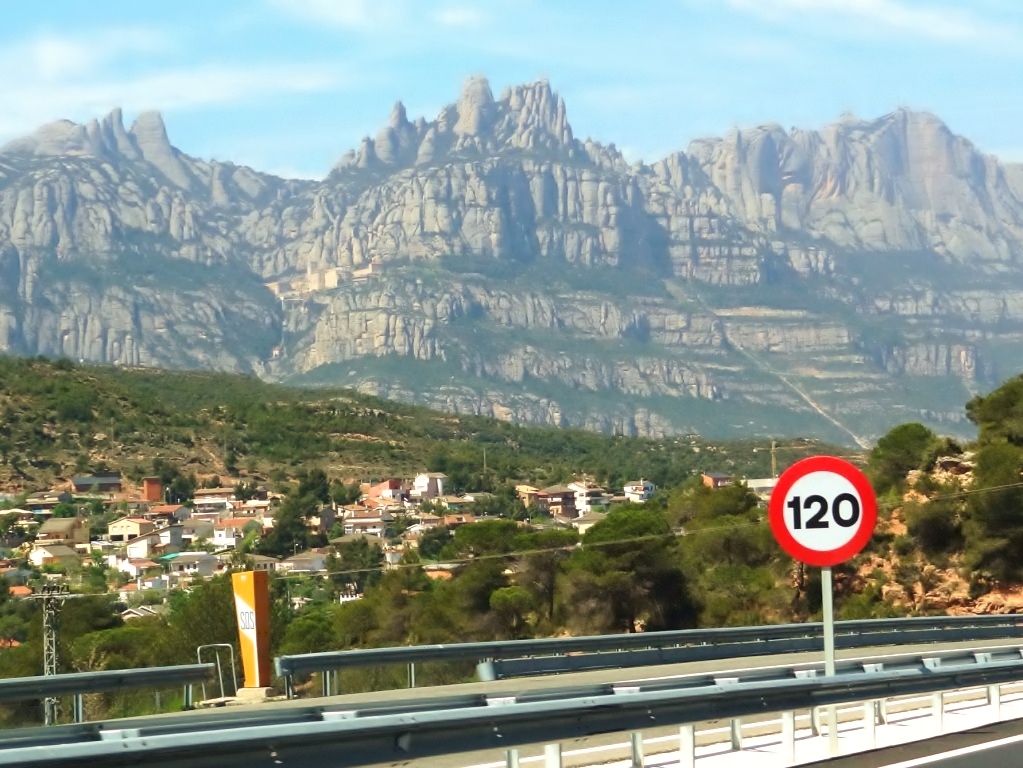Now
that it is Easter I thought it appropriate to post a report on the
visit we made to the Montserrat monastery
in Catalonia, Spain, two years ago in
late April. We were driving on the motorway inland from Barcelona and all of a sudden
the majestic Montserrat mountain range, with the serrated tops as if made by
sawing, were there. Had we known the buildings on the narrow mountain terrace
are this clearly visible to the valley of the Llobregat river we would have
taken a smaller road to be able to stop for some decent photos.
 |
| The village of Monistrol de Montserrat. |
The
Benedictine monastery of Santa Maria de Montserrat is the most visited
pilgrimage site in Catalonia. It can be reached by cable car and rack railway
but there is also quite a row of pay parking spaces up there for those arriving
by car. As it wasn’t high season we ventured on the serpentine road. We
certainly weren’t disappointed! The views along the way were magnificent.
So
were those from the lookouts by the abbey. There has been a shrine on the
spectacular Montserrat mountains from Roman times. The temple of Venus gave way
to the first monastery in the 9th century AD. Some 300 years later, the abbey started
to see a strong growth period thanks to the legend of miracles attributed to
the Virgin of Montserrat or the Black Madonna, a wooden statue of the Madonna
and Child also called ‘La Moreneta’,
the little dark-skinned one. It is one of the few European black Madonnas,
although recent research has revealed the statue wasn’t originally black but
has been darkened over time and because of that also painted black when being
restored over the centuries.
The
monastery was largely destroyed by Napoleon’s troops and was rebuilt in
the 19th and 20th centuries. Even during our visit the square in front of the
buildings was under construction, which served as an excuse to concentrate on
shooting the interior of the basilica.
There
was a continuous queue of pilgrims and other travellers not only to and from
the parking lot but also to the Black Madonna up above the main altar area. The
Virgin of Montserrat is one of the patron saints of Catalonia, the other one
being Saint George (more about him in another post of mine here). Visitors are pouring increasingly also from outside the surrounding
area to pay tribute to the Madonna and touch her hand for her blessing.
The
decorative interior of the basilica boasts golden glaze and many beautiful 2oth
century artworks. I liked especially the art nouveau paintings on the walls of
the choir. To me, however, the most striking piece was the simple altar in the
Chapel of the Holy Sacrament, showing the face of Christ and his hands and feet
as if he were emerging out of a winding sheet or a rough wooden coffin. The
powerful work of art is a single concrete piece made in 1977 by the Catalan
sculptor Josep Maria Subirachs, who
died earlier this month at the age of 87. It is a refreshing exception to his
angular style that is not much to my taste.
There is a nice art museum at Montserrat with works ranging from those of old masters such as Caravaggio and El Greco to those of many beloved artists from the 19th and 20th centuries such as Monet, Degas, Picasso, Miró and Dalí. Most of the artworks have been acquired as donations from private persons, some from the artists themselves. The museum also houses an archaeological and an ecclesiastical collection.
In addition to the Black Madonna, the world-famous Montserrat Boys Choir keeps attracting busses full of travellers to the mountain. The choir performs in the basilica every day at 1 pm. We were unfortunate enough to arrive too late to hear that. Today, the choir consists of some 50 boys between the ages of 9 and 14. Besides singing in the choir, the musical education given at the monastery to each boy includes lessons in playing the piano and an additional instrument of his choosing.
.jpg) |
| Montserrat humour? Probably accidental. That of the guys at the ad agency perhaps. |
The
site itself was not particularly to our liking. We prefer to promote our
spirituality in less busy settings with less of the market place mentality so
often built up around prominent Roman Catholic attractions. But the location of the
monastery up on the mountain terrace overlooking the Catalonian countryside and
the fabulous Montserrat peaks is simply fantastic.
 |
| The sanctuary of the Santa Cova or the Holy Grotto with the cave where the Black Madonna is believed to have been found. |
There are several picturesque paths leading from the monastery to the hermitages in the mountains that constitute the Montserrat Natural Park. I feel walking those paths would be the best Montserrat could offer, a truly unique opportunity to admire the surrounding wonders, both natural and man-made. On a clear day, they say, you can see from the highest peak as far as to the island of Mallorca.



.jpg)















.jpg)




Uskomattoman hienolla paikalla tuo luostari sijaitsee. Järjettömän upeat vuoret ja siellä sylissä tiiviisti luostari...kaunista.
ReplyDeleteEi ihme, että näitä vuoria on pidetty pyhinä kautta aikojen.
Delete